Fasting- Unveiling Surprising Facts using Science (Complete Guide)
Table of Contents
What you will learn in this article about fasting?
For decades, I always kept wondering why every religion mandates few days of fasting. Food, to me, was the source of energy that makes our body continue living. Then, what’s the point of punishing our body by depriving this energy?
A lot of blogs and articles across the Internet have tried answering this question. In this article, I have attempted to take a scientist’s approach by analyzing all the available data. But I have also tried my best to present the findings in a manner that even a layman can understand. (That’s the objective of this website anyway!). At the end of this, you will understand what really science is saying about fasting and will guide to adopt rational practices to get the maximum benefits.
I will start by introducing how I became interested in this science of fasting. Then I will try introducing to various definitions of fasting before taking through the perspectives of various religions on this topic. Post that, I will go on to core science part of this article.
Fasting and Chicken Curry!
(For who would like to move straight to the scientific part of this article, please click here)
I grew up in an environment that was invariably at the intersection of “blindly” followed Hindu cultural practices at home and “rational” learning at school. Both were consistently at loggerheads with each other.
And both co-existed as a paradox! We had a teacher who would vehemently oppose the irrational superstition that sight of owls can bring bad luck and signify death. However, the same teacher also would freeze with fright if a black cat crossed her path. So, in the midst of such paradoxes, I remained perennially confused throughout my childhood about the path I should take.
In general, influence of books that you read as a kid and what is taught in school tend to override what is practiced and taught at home. That was exactly the case with me.
I think I was 14 years old when I had a violent argument with my dad. That day I was at Liju’s place (my friend from school) for group studies. Liju’s mom was (and still is) an awesome cook. She prepared South Indian style chicken curry served with Neer Dosas (kind of super-thin Indian breads made of rice). It’s too tempting for anyone to skip. Hence, I, who had already decided that my parents were orthodox and superstitious, pounced upon that super tasty chicken and overstuffed myself. (While I am writing this, my mouth is watering automatically!) So full I was, when I returned home, I couldn’t eat anything during lunch. And innocently and somewhat excitedly I told my parents what an excellent cook Liju’s mom was and how luscious was that chicken curry.

Immediately my dad stood up from his place leaving his half-finished plate of food and started shouting at me. My mom was equally vocal in concluding that I had no respect for my family traditions. And in those exchanges of words, I ended up declaring that the traditions we followed were merely illogical superstitions and were a sign of illiteracy.
That was when I declared that I was an atheist. It was a kind of turning point in my life because since then I started consciously flouting all religious norms that I earlier used to adhere to.
The whole fuss about me having chicken curry at Liju’ s place was that it was a Thursday. And in my family, Thursday was always a compulsory “purely vegetarian” day. It just skipped my mind that it was Thursday. I had no intention to break the rule (though, at that time, I had lost my faith on such practices).
Let Us Define Fasting First
Fasting can be defined as restriction in intake of calories. There are several terms that are used while discussing fasting.
- Calorie restriction (CR) usually refers to a daily reduction by 15–40% of calorie intake without causing malnutrition.
- Intermittent fasting (IF) refers to fasting lengths between 16 and 48 h, alternated with usual food intake. alternate day fasting (ADF) is the most frequently studied IF procedure, whereby normal food intake occurs on one day and restricted food the next day.
- Time restricted eating/feeding (TRE/TRF) involves intake of food occurring within a time window of 8–12 h per day or less.
- Periodic fasting (PF) means cycles of fasting or calorie restricted diets. One example is the the 5:2 diet which refers to two days per week of reduced food intake, consecutive or not. In these two days food intake is drastically reduced to approximately 600 kcal. Some authors consider 5:2 diet as a form of IF. Periods of fasting lasting from many days to weeks have sometimes been referred to as periodic as they can be repeated every year. But, some authors refer to them as long-term or prolonged fasting.
- Long-term fasting (LF) is near- complete food abstinence from 2 to 21 days or more. During this period no or minimal amounts of calories, up to 200–250 kcal/days are taken within appropriate schedules.
- Other regimens: These are derived from fasting strategies. Very-low-calorie- diets (VLCD) is a hypocaloric formula diet providing 80–100 g of proteins and an average of 1000 kcal/days. The fasting mimicking diet (FMD) is a hypocaloric (800–1100 kcal), low protein, ketogenic diet.
Ramadan, Lent, Ekadashi, Shivratri- The Worldwide Culture of Fasting
(For who would like to move straight to the scientific part of this article, please click here)
Avoiding non vegetarian food on Thursdays was a norm in my family- it was just compulsory. There were few other rituals that were followed by my parents, but I was never forced to follow. My parents would resort to full day fasting on certain specific days. Sometimes I would also join them.
Few of these fasting rituals used to be very stringent. For example, during Diwali (festival of lights in India) there is a specific day when Goddess Kali is worshiped. Every year, on this day known as Kali Puja, I and my dad would fast for more than 24 hours. During this fast, we would not even drink water. We would end the fast long after midnight once the priest declared that the rituals are over and now fast can be broken.
Even after that momentous Thursday when I declared blasphemously at the top of my voice to my parents that I was an atheist, I still would the fast during every Kali Puja (I still do). The only difference was, just to ensure that the rebel in me gets its fair place, I would break the fast right before the ritual was declared over!
Fasting is a pan religion custom. Irrespective of what religion you study- Hinduism, Islam, Christianity, Judaism, Buddhism- fasting is prescribed.
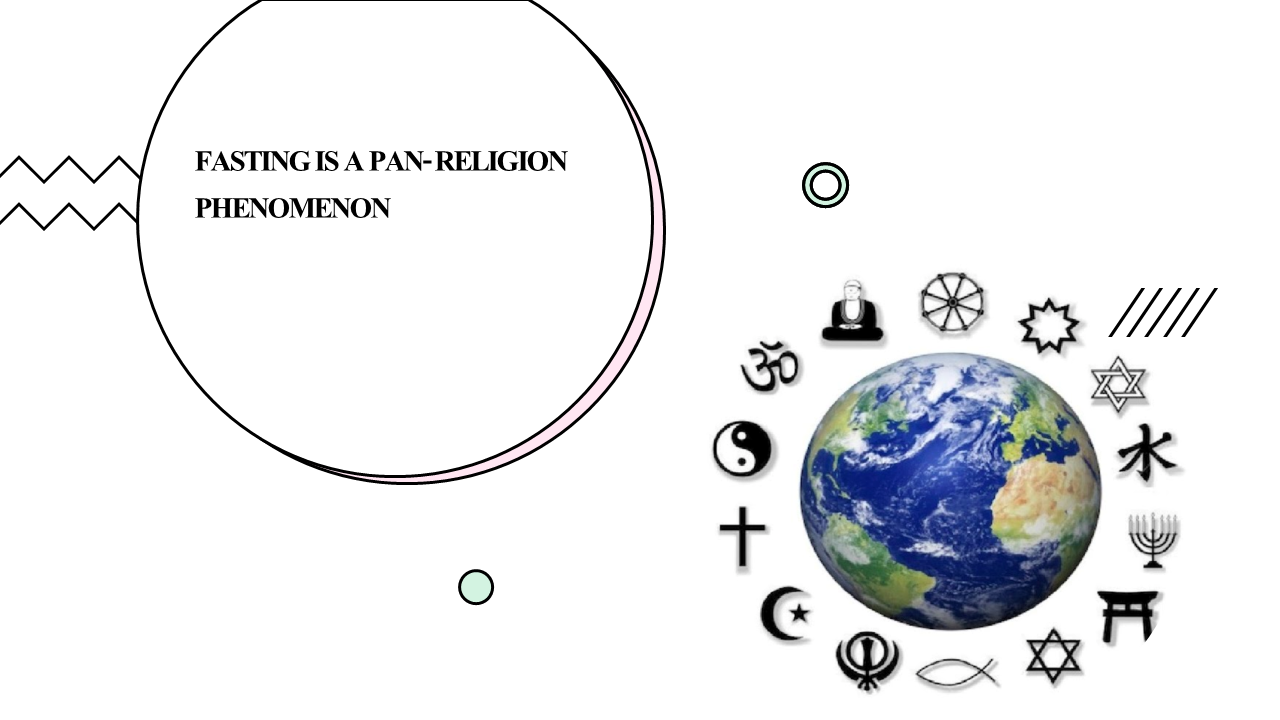
Islam is one of the three Abrahamic, monotheistic faiths, along with Christianity and Judaism. Characterized by a rich and millennial history, Islam is the second largest religion in the world, accounting for approximately a quarter of the entire global population.
The month of Ramadan is the ninth month of the Islamic calendar. Fasting during the month of Ramadan is one of the five pillars of the Islam creed. Ramadan fasting is not just abstinence from eating- it also includes abstinence from drinking, and smoking, as well as from sexual intercourses, from sunrise until sunset.
The Verses 183-185 of Surat “Al-Baqarah” mention the following: “O you who have believed, decreed upon you is fasting as it was decreed upon those before you that you may become righteous – [Fasting for] a limited number of days”.
 Islamic calendar is lunar and is very different from the solar or Gregorian calendar followed by Christians. The Islamic year contains 354 days, and therefore Ramadan moves back 11 days every year and may fall during any of the four seasons, making the duration of daily fasting vary from 10–11 hours in the winter to 18–20 hours in the summer period, with an average of 15 hours, depending on the geographical location and on the timing of the month of Ramadan during the seasonal cycle. The month of Ramadan is either 29 or 30 days. During the month of Ramadan, Muslims consume only two major meals, one shortly before dawn (called “Suhoor”) and the other immediately after sunset (called “Iftar”). It should be noted that the Ramadan fasting represents a unique form of fasting, in that it consists of alternate abstinence and feasting (re-feeding) periods, following the circadian rhythm. It is, therefore, an intermittent fasting or, according to some scholars, a time-restricted feeding.
Islamic calendar is lunar and is very different from the solar or Gregorian calendar followed by Christians. The Islamic year contains 354 days, and therefore Ramadan moves back 11 days every year and may fall during any of the four seasons, making the duration of daily fasting vary from 10–11 hours in the winter to 18–20 hours in the summer period, with an average of 15 hours, depending on the geographical location and on the timing of the month of Ramadan during the seasonal cycle. The month of Ramadan is either 29 or 30 days. During the month of Ramadan, Muslims consume only two major meals, one shortly before dawn (called “Suhoor”) and the other immediately after sunset (called “Iftar”). It should be noted that the Ramadan fasting represents a unique form of fasting, in that it consists of alternate abstinence and feasting (re-feeding) periods, following the circadian rhythm. It is, therefore, an intermittent fasting or, according to some scholars, a time-restricted feeding.
Ramadan fasting is not compulsory for prepubescent children, menstruating females, travels, and sick subjects. Pregnant and lactating females are also exempt and allowed to delay their fasting to a suitable period when it can be performed without it disturbing their maternal obligations.
 With about 2.4 billion followers as of 2020, Christianity is the world’s largest religion in 157 countries and territories. Christians follow a 40 days period of fasting every year before Easter. Easter celebrates the resurrection of Jesus after his death on the cross. But Lent recalls the events leading up to Jesus Christ’s crucifixion by Rome. By observing the 40 days of Lent fasting, Christians try to pay homage and replicate Jesus Christ’s sacrifice and withdrawal into the desert for 40 days
With about 2.4 billion followers as of 2020, Christianity is the world’s largest religion in 157 countries and territories. Christians follow a 40 days period of fasting every year before Easter. Easter celebrates the resurrection of Jesus after his death on the cross. But Lent recalls the events leading up to Jesus Christ’s crucifixion by Rome. By observing the 40 days of Lent fasting, Christians try to pay homage and replicate Jesus Christ’s sacrifice and withdrawal into the desert for 40 days
Hinduism is the world’s third-largest religion. There are over 1.25 billion followers, representing around 15–16% of the global population. It is also amongst the oldest of all religions (supposed to have originated in the Indian subcontinent between 1500-500 BC). Fasting is an integral aspect of Hindu Dharma.  As per Hindu scriptures fasting is a moral and spiritual act where the aim is to purify the body and mind to acquire divine grace. It is believed that fasting helps create an attunement with God by establishing a harmonious relationship between the body and the soul. Unlike Christianity or Islam, Hinduism is not monotheistic Abrahamic. There is no founder messenger from any higher power that started Hinduism. Hinduism is polytheistic. There are approximately 330 million deities (Gods and Goddesses) in Hinduism. Hence there are differences in how fasting is observed in Hinduism. Unlike Islam or Christianity, Hinduism prescribes fasting all through the year for certain days. The Hindu calendar is very different. Unlike Christian calendar (sun based) or Islam calendar (moon based), Hindu calendar is based on both the sun as well as the moon- It uses a solar year but divides it into 12 lunar months.
As per Hindu scriptures fasting is a moral and spiritual act where the aim is to purify the body and mind to acquire divine grace. It is believed that fasting helps create an attunement with God by establishing a harmonious relationship between the body and the soul. Unlike Christianity or Islam, Hinduism is not monotheistic Abrahamic. There is no founder messenger from any higher power that started Hinduism. Hinduism is polytheistic. There are approximately 330 million deities (Gods and Goddesses) in Hinduism. Hence there are differences in how fasting is observed in Hinduism. Unlike Islam or Christianity, Hinduism prescribes fasting all through the year for certain days. The Hindu calendar is very different. Unlike Christian calendar (sun based) or Islam calendar (moon based), Hindu calendar is based on both the sun as well as the moon- It uses a solar year but divides it into 12 lunar months.
Hindus consider Shravaṇa to be the holiest month of the year. Shravaṇa usually falls in July / August or August / September. Many Hindus will observe a period of fasting during this month. Navaratri is a nine-night celebration of the Feminine Divine. It occurs five times annually- however most celebrate the spring and the fall ones. In Hinduism certain days of the week are dedicated to a particular deity and many observe fast on those days to honor that particular deity. Devotees of Lord Śhiva often observe fasting on Mondays. Devotees of Lord Viṣhṇu do so on Thursdays. Similarly, certain days of the month are marked for fasting. For example, on Poornima (full moon day) and Ekadashi (which is the eleventh day after the full moon) thousands of Hindus fast.
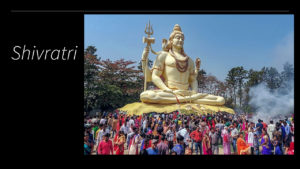 There is no single form of fasting that is practiced through Hinduism. During Shivratri and Kali Puja, fasting involves not having food and water or any beverage for more than 24 hours. In some cases, fasting involves abstaining from one meal in the day. In few others it is sufficient to eliminate certain types of food (most often meat). I certainly enjoyed being part of this last type of fasting- my mom would generally prepare very tasty meals, viz. sabudana khichdi (sago porridge) etc to compensate for the restriction!
There is no single form of fasting that is practiced through Hinduism. During Shivratri and Kali Puja, fasting involves not having food and water or any beverage for more than 24 hours. In some cases, fasting involves abstaining from one meal in the day. In few others it is sufficient to eliminate certain types of food (most often meat). I certainly enjoyed being part of this last type of fasting- my mom would generally prepare very tasty meals, viz. sabudana khichdi (sago porridge) etc to compensate for the restriction!
Manusmriti, the traditional Hindu book of rules, prescribes fasting for both men and women with elaborate rules and procedures. In one form of fasting it prescribes that the subject must eat first three days only in the morning, for the next three days only in the evening, for the next three days eat only what has been given to him unasked and observe complete fasting during the last three days. In another type of fasting, the practitioner must reduce the daily intake of food by one mouthful per day during the dark half of the month and increase it by a mouthful during the bright half.
Understanding Meaning of Fasting through Lens of Nature
(For who would like to move straight to the scientific part of this article, please click here)
We are what we are now because of the process of evolution that has been crafting us since millions of years. Throughout this evolution there have always been alternating periods of food availability and food scarcity, mostly due to seasonal cycles with variations in sunlight exposure. Adversities of nature such as ice ages, volcanoes etc have had serious impact on humanity’s access to food since many generations.
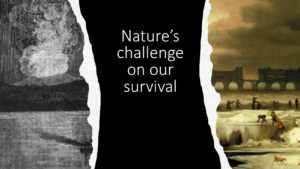 For example, just around five thousand years ago, earth experience a temperature drop of around two degrees Celsius, or 3.6 degrees Fahrenheit. This drop lasted for around 100 years. Although seemingly minor drop, this Little Ice Age that started in 14th century AD led to long term agricultural crisis world-wide. In 1815 the volcano at Mount Tambora, Indonesia erupted. It was the largest eruption in recorded history. The volcano ejected an estimated 150 cubic kilometers of debris into the air. The amount of debris was so enormous that it severely impacted earth’s temperature, cooling it by as much as 3° Celsius. This resulted in extreme weather globally for three years. There was no summer in North America and Europe in 1816 and led to widespread crop failure.
For example, just around five thousand years ago, earth experience a temperature drop of around two degrees Celsius, or 3.6 degrees Fahrenheit. This drop lasted for around 100 years. Although seemingly minor drop, this Little Ice Age that started in 14th century AD led to long term agricultural crisis world-wide. In 1815 the volcano at Mount Tambora, Indonesia erupted. It was the largest eruption in recorded history. The volcano ejected an estimated 150 cubic kilometers of debris into the air. The amount of debris was so enormous that it severely impacted earth’s temperature, cooling it by as much as 3° Celsius. This resulted in extreme weather globally for three years. There was no summer in North America and Europe in 1816 and led to widespread crop failure.
But we have always survived. We kept evolving to such challenges. During this course of evolution we gradually built our body in such a way there is enough stored form of energy that can help our body tide through extended periods of food scarcity. This we do via storing energy in the form of fat. Someone might ask here- why fat? To understand this, imagine a fan that runs on electricity from a generator. The electricity generator itself can be imagined as carbohydrate. Fat is akin to an electricity back-up that will still supply electricity in case the generator shuts down. The fan itself can be imagined as protein. Carbohydrates are great in producing energy quickly, are too volatile to be stored for long term. Proteins are not meant for energy production at all. In fact, their usage for energy production is toxic for the cells. Body will use proteins for energy production only when there is no option- when carbohydrates are not available, and fats are also burnt out. Also, it’s easy to store fat beneath the skin in huge quantities. But the most important reason is simply that fat is energy dense- 1 gm of fat can produce 9 calories while 1 gm each of carbohydrate or protein can produce only 4 calories.
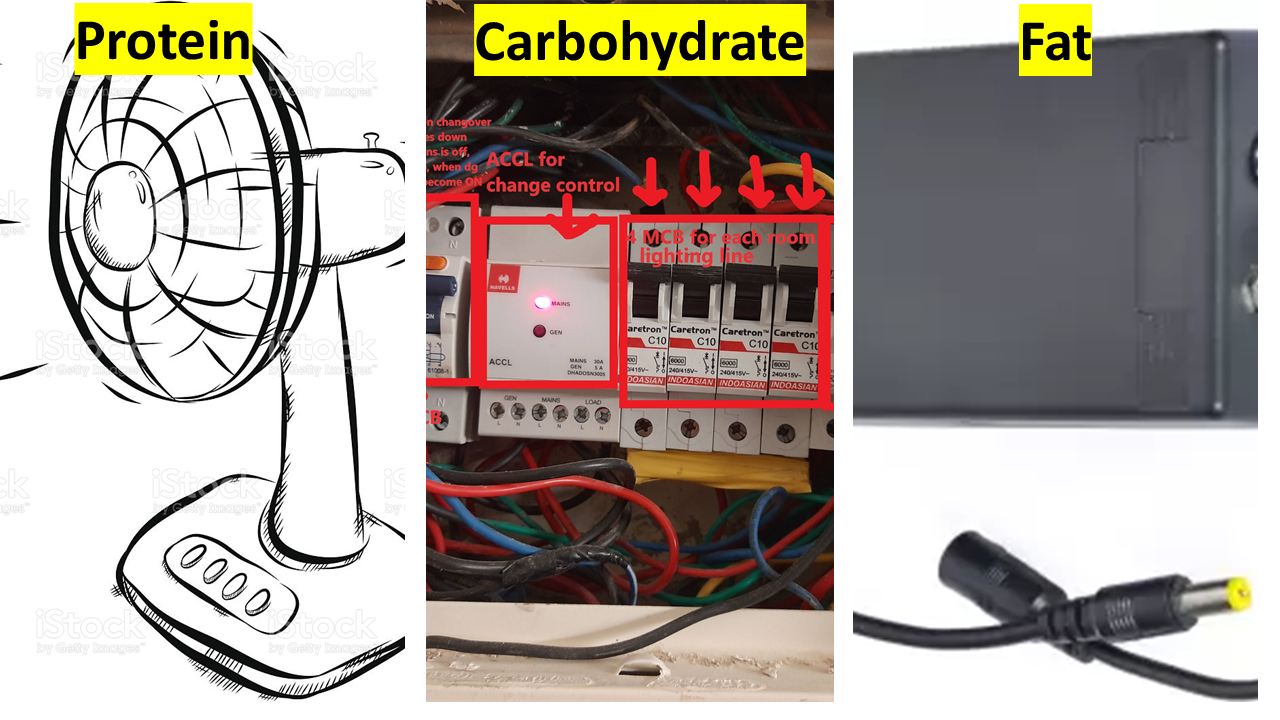
If this is true, then why not use fat as the primary source of energy? Point is carbohydrate is extremely abundant and fat is not. It will be really inefficient to eat something that is mostly carbohydrate, then convert it into fat and then derive energy. So, what body does is, it immediately uses required amount of carbohydrates to generate energy, stores some as glycogen (a reserve form of carbohydrate) and converts the remaining excess carbohydrates into fat.
Storing energy in the form of fat was a highly efficient solution for humans and animals to cope with the absence of food supply and it permitted to fuel prolonged periods of fasting. Prolonged periods of fasting is very common in animal world. Bears and ground squirrels restrict energy expenditure during hibernation. During this period, they undergo prolonged fasting periods of months with no or little food.  Emperor penguins in Antarctica fast during molting (shedding of feathers) and breeding. During fasting these emperor penguins can stand colder conditions better than any other bird, while maintaining their usual body temperature (this is also aided by the huddling process used by penguins). During migration birds fly hundreds of kilometers without any food. Animals in the wild regularly survive long periods with little or no food. For example, wolves living in the Northern Rocky Mountains of the United States typically fail in king prey every day. They succeed only once every one or two weeks. Their success depends upon efficient functioning of their brains and bodies. This efficiency allows them to co-ordinate with their pack mates and execute a strategy to capture and kill the prey animal. Without constant energy source such efficiency is unthinkable. But, these wolves have a very flexible metabolism that allows them to use energy from stored fat quickly.
Emperor penguins in Antarctica fast during molting (shedding of feathers) and breeding. During fasting these emperor penguins can stand colder conditions better than any other bird, while maintaining their usual body temperature (this is also aided by the huddling process used by penguins). During migration birds fly hundreds of kilometers without any food. Animals in the wild regularly survive long periods with little or no food. For example, wolves living in the Northern Rocky Mountains of the United States typically fail in king prey every day. They succeed only once every one or two weeks. Their success depends upon efficient functioning of their brains and bodies. This efficiency allows them to co-ordinate with their pack mates and execute a strategy to capture and kill the prey animal. Without constant energy source such efficiency is unthinkable. But, these wolves have a very flexible metabolism that allows them to use energy from stored fat quickly.
In nature, those individuals whose brains and bodies perform optimally in a food deprived/fasted state would has a survival advantage. And, we- human beings- are definitely amongst the best of these survivors!
Simplifying Science of Fasting- The “Coal” and the “Fire”
This is the most important section of this article. I want you readers to open your mind for a crazy ride of imagination. And believe me, at the end of this ride there is beautiful truth which can’t be understood without you taking help of your imagination.
Imagine a train that runs on coal. There is a fire- man on this train whose job is to keep shoveling coal into the firebox. More the coal available, faster it will be pushed into the firebox. So long as there is coal in the firebox and the coal is burning the train shall keep moving. More the coal, fiercer is the “fire” and faster will be the pace at which the train moves. Of course, the fire can’t be too fierce- else it might end up “burning” and destroying the whole train. To prevent this eventuality, around the firebox (where coal is burning) there are multiple water sprinklers. When the fire is optimal, sprinklers are “off” and when it goes a bit out of control the sprinklers start spraying water. There is a repair- guy on this train whose job is to repair any damage that happens on this train while it is moving. He is also the one who keeps ensuring that water sprinklers are working properly.
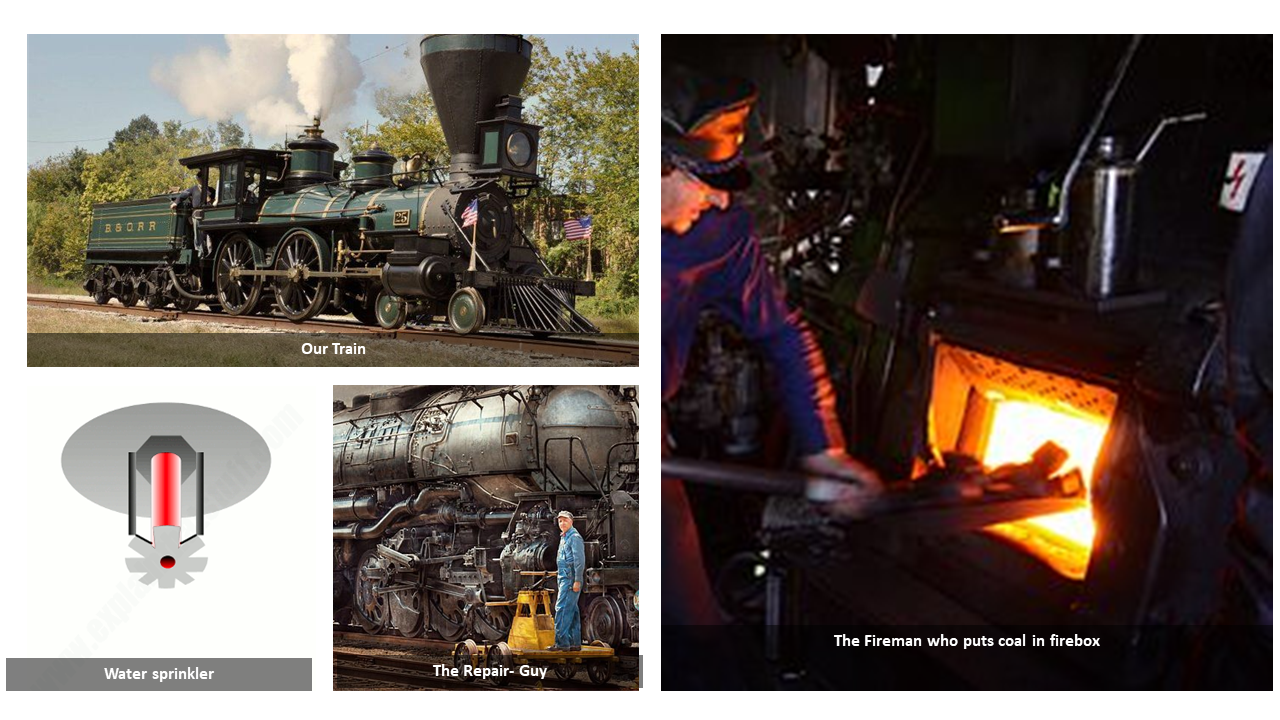 As this train is moving, little by little its parts are getting damaged. This damage is the result of wear- and – tear during to the fire burning and the wheel and the axle moving. Hotter the flame, more is the damage. Faster the train, higher is the damage. But, we have seen, there are controls. The water sprinkler does not allow the fire to become too hot. The repair- guy ensures that any damage is immediately repaired.
As this train is moving, little by little its parts are getting damaged. This damage is the result of wear- and – tear during to the fire burning and the wheel and the axle moving. Hotter the flame, more is the damage. Faster the train, higher is the damage. But, we have seen, there are controls. The water sprinkler does not allow the fire to become too hot. The repair- guy ensures that any damage is immediately repaired.
But remember: this repair- guy is just one guy and has limited capacity. He does his job best when the fire from coal is not too hot and the train is moving slowly. Fiercer the fire and faster the train, slower will be the response from this repair- guy. Also, if the train has now been running for years our repair-guy is also getting old. With age, he is slowly becoming slower and inefficient. Eventually, the amount of damage will be too much for him to handle and the train will fall apart and stop moving. Similarly, the water sprinklers are also getting damaged with time. A moment will come when it is not able to sprinkle water efficiently. The fire, then, will soon become uncontrollably violent devouring the entire train. Once again, eventually, train will come to a halt. Both- the failing repair guy and the failing water sprinklers- will cause each other to fail more.
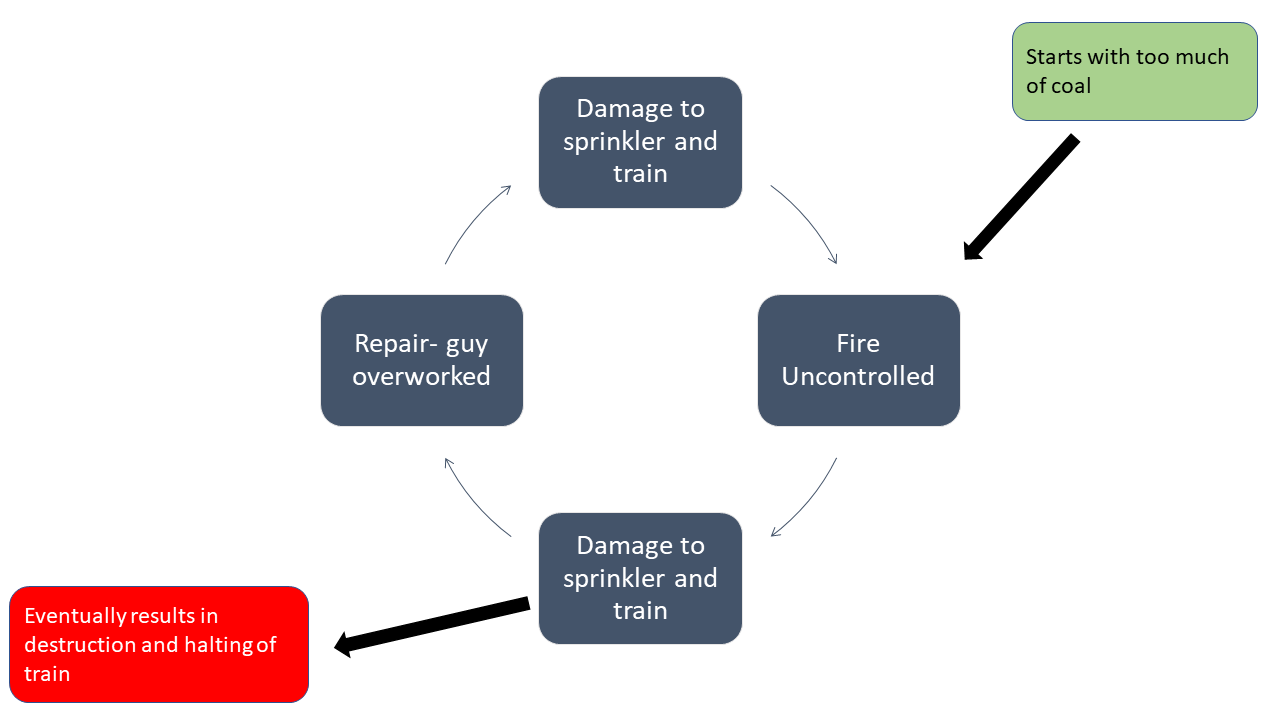 In this imagination, don’t forget the fireman whose job is to shovel coal into firebox. He is actually the most important character- without him the train just won’t move. No good water sprinkler and efficient repair- guy will be of any use, if you don’t have a fireman. But this fireman is a dumb guy- he has no brains. His act of putting coal into fire is directly dependent on amount of coal- more the coal, more he will put into the firebox. But if that happens, sprinklers will get overworked and eventually fail dousing the roaring fire. Train will run faster than ever- this will accelerate “wear and tear” leading to damages piling up. The repair- guy will fail in his job because we saw that he is inefficient if the fire is too hot or the train is moving fast (here it’s both!).
In this imagination, don’t forget the fireman whose job is to shovel coal into firebox. He is actually the most important character- without him the train just won’t move. No good water sprinkler and efficient repair- guy will be of any use, if you don’t have a fireman. But this fireman is a dumb guy- he has no brains. His act of putting coal into fire is directly dependent on amount of coal- more the coal, more he will put into the firebox. But if that happens, sprinklers will get overworked and eventually fail dousing the roaring fire. Train will run faster than ever- this will accelerate “wear and tear” leading to damages piling up. The repair- guy will fail in his job because we saw that he is inefficient if the fire is too hot or the train is moving fast (here it’s both!).
Now, lets give some perspective to this picture we just imagined. The train is our life. The coal is the food that we eat. The fire is the energy that our body cells derive from the food we eat. The water sprinklers and the repair- guy are the “healing” mechanisms we have in our body.
Whenever we eat food, we create energy. This energy is actually created via “small generators” known as mitochondria inside our cells. These mitochondria are extremely efficient. However, despite their efficiency, the process of energy generation is dangerous. Generating energy through mitochondria is like the burning of coal- it generates heat. While the energy is used for driving all the cellular functions, the heat itself is truly damaging. This damage can go onto tear the DNA and cause damage to cell membranes. A healthy mitochondrion ensures that this heat generation is minimal. Further, there are heat minimizing systems in the cells that decrease the extent of damage (like the water sprinklers of our imaginary train). Even if damage happens, we have extensive repair mechanisms to do corrections (like the repair- guy).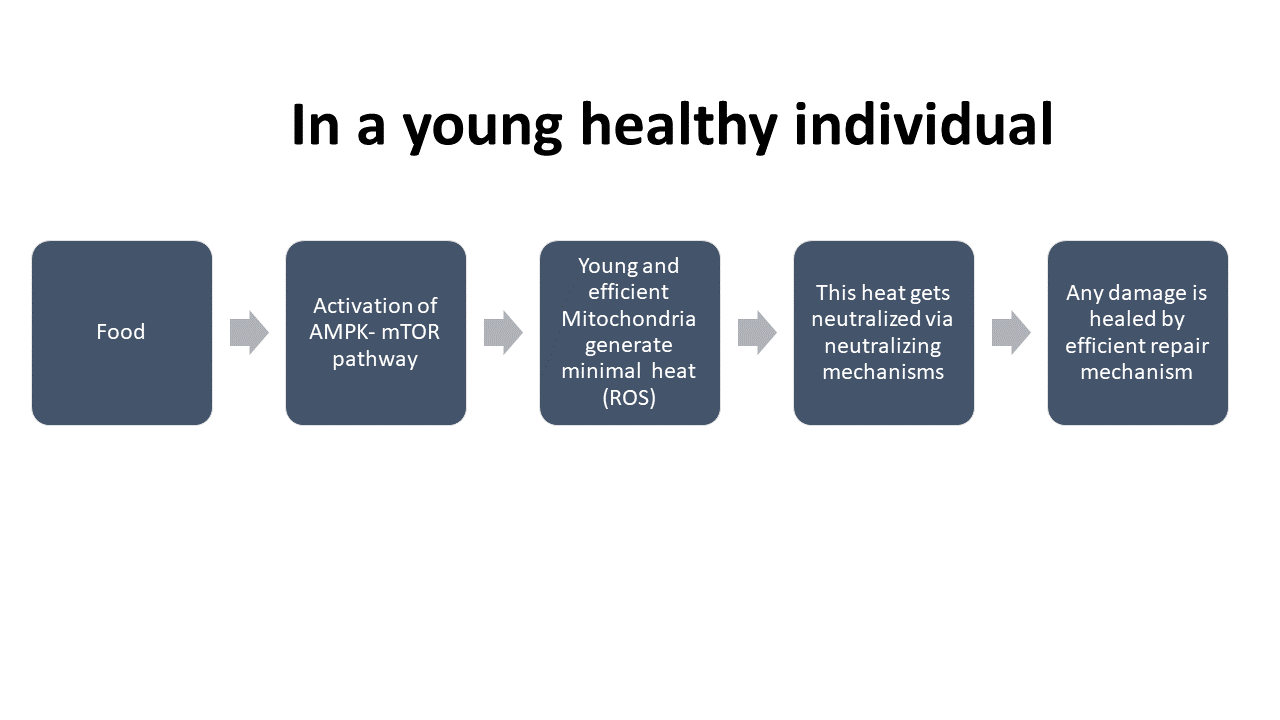
While I don’t want to go technical here, the heat here refers to formation of “reactive oxygen species” (also known as ROS) which cause damage to cellular membranes and genome. To counter this damage we have various “healing mechanisms”. For example, there are checkpoint mechanisms to reverse the damage that happens at the level of DNA.
All this is good so long as every component works efficiently. Efficient mitochondria ensure minimal heat generation and whatever heat is generated is doused off efficiently and even if any damage happens, repair is fast and seamless. But with age, the heat minimizing systems start becoming more and more inefficient. Similarly, the repair mechanisms also slowly start losing their grip. And as we saw while we were imagining our train- when the heat minimizing systems fail, it leads to failure of the repair mechanisms, and vice versa. Once this starts, the heat generated from energy production will start causing damage that can’t be repaired. Slowly our body ages towards death. This is actually how aging progresses. The damage also impacts the very mitochondria that produce energy. Remember we said an efficient healthy mitochondrion ensures minimal heat and that this minimal heat itself has damaging potential. So, with the support from heat minimizing systems failing, this minimal heat generated ends up damaging the mitochondria. A damaged mitochondrion is inefficient and now produces much more heat than normal while generating energy. So, more heat- more damage- more inefficiency- more heat. It’s a vicious cycle similar to what we saw with our imaginary train.
 Now it will all start making sense. When you are young and healthy, you may afford to eat as frequently as possible. The young efficient mitochondria will burn this fuel (food), with low heat production. The protection and the repair mechanisms are also very effective in minimizing the effect of this heat. As we age, this efficiency of mitochondria and the systems dampening impact of heat production keeps going down. Hence slowly energy generation from food starts damaging every system around increasingly. And, this where fasting comes to rescue!
Now it will all start making sense. When you are young and healthy, you may afford to eat as frequently as possible. The young efficient mitochondria will burn this fuel (food), with low heat production. The protection and the repair mechanisms are also very effective in minimizing the effect of this heat. As we age, this efficiency of mitochondria and the systems dampening impact of heat production keeps going down. Hence slowly energy generation from food starts damaging every system around increasingly. And, this where fasting comes to rescue!
The Science of Fasting- Unlocking Autophagy
In our imaginary train story, we said that the most important character is the fireman whose job is to shovel coal into firebox. We stressed that without him the train just won’t move and no good water sprinkler and efficient repair- guy will be of any use, if you don’t have a fireman. We also said that this fireman does not think- it and just keeps shoveling coal into firebox. So, more is the coal, more blazing will the fire.
In a cell this fireman is a system known as AMPK- mTOR pathway (AMPK is Adenosine Mono Phosphate activated Protein Kinase and mTOR stands for mammalian Target of Rapamycin. No need to remember these complicated names!). Whenever you eat, AMPK- mTOR pathway gets activated. AMPK- mTOR pathway activation pushes mitochondria to produce energy. More the food- more is the activation of this pathway- more is the energy production.
Now, armed with these concepts, you will easily start appreciating why fasting is so important. Fasting helps just like sleep. Throughout the day, being awake and active puts a lot of stress on all the cellular systems. When we sleep, activity slows down, and our body starts healing and repairing any damage that was caused while we were awake.
It’s similar to what happens on Sundays when few trains are kept non- operational. During these periods the trains as well as the respective railway tracks are checked, and appropriately repaired wherever its needed.
Just like sleep, fasting allows cellular systems to cool down and rejuvenate. It gives time for the damaged systems to heal the themselves. Fasting reduces the amount of food available. This slows down our fireman- the AMPK mTOR pathway. Automatically mitochondria go into resting phase. Amount of energy produced goes down and thus goes down the heat production. This allows the repair mechanisms to function with full force (remember: our repair- guy is most efficient when train is moving slowly, and fire is not that hot!).
One of the most important repair mechanisms that gets activated during fasting goes by the name “autophagy”. Autophagy means “eating self”. What autophagy does is, it identifies all cellular machinery with damages. Once these “defective pieces” have been identified, they are “eaten up” and destroyed- hence the name autophagy. These are then replaced by new healthy components, and the healing is now complete!
Imagine that during inspection, it is found that one of wheels has developed a crack. This can be taken care off by removing this defective wheel with a new one. This is what autophagy does during fasting- it eliminates the defective components and those are replaced by new healthy ones.
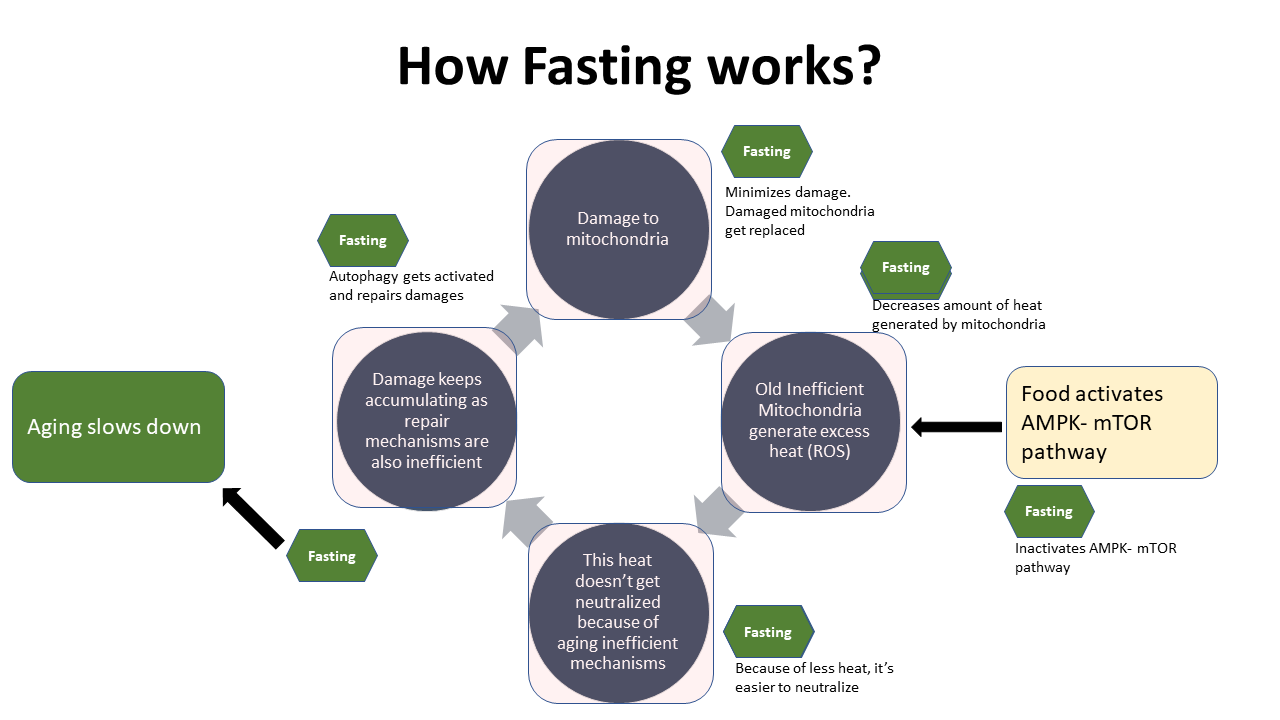 In early stages of life, it might not be really essential to resort to fasting (although I strongly believe it will help slow down the aging process and keep body healthier). But in later period of life (once puberty starts), fasting is definite essential and must be observed as frequently as possible. The damage from energy production is an important reason why you age. It is really important to ensure that the damage that is happening does not keep accumulating. Each form of damage adds to others damages around and they keep multiplying. More frequently you fast, more is chance you give to your body to repair and heal. Your aging is a direct function of AMPK- mTOR pathway activation- lesser the better. Fasting ensures AMPK- mTOR pathway activation is always low.
In early stages of life, it might not be really essential to resort to fasting (although I strongly believe it will help slow down the aging process and keep body healthier). But in later period of life (once puberty starts), fasting is definite essential and must be observed as frequently as possible. The damage from energy production is an important reason why you age. It is really important to ensure that the damage that is happening does not keep accumulating. Each form of damage adds to others damages around and they keep multiplying. More frequently you fast, more is chance you give to your body to repair and heal. Your aging is a direct function of AMPK- mTOR pathway activation- lesser the better. Fasting ensures AMPK- mTOR pathway activation is always low.
What is science saying about benefits of fasting proven?
Any theory is just a theory unless proven with scientific methods. Weight loss is a direct outcome of fasting and one need not be a scientist to understand why. However, the fasting benefits that we discussed about are also thoroughly evidenced and well documented.
Fasting improves health and slows aging
Studies in animals have already proven that fasting massively slows down aging and improves longevity. Fasting studies in mice revealed tremendous improvement in brain and heart functionalities. Fasting also remarkably reduces chances of cancer, diabetes and kidney disease. Multiple studies have shown that observing fasts achieves excellent blood sugar control amongst diabetics. Similarly, patients with hypertension have been shown to achieve better control over their blood pressures. Fasting makes your heart healthier and reduces the chances of heart attacks. Stroke is a dreaded event and its risk keeps increasing with age. Fasting directly reduces the chances of stroke.
Beware of Proteins
Despite increasing aversion to religion driven customs and traditions luckily fasting practices has been embraced by 21st century whole- heartedly. And this is simply because fasting practices help losing weight. “Zero figure” fad has led to various “dieting” programs become multi-million-dollar businesses. There are several programs- each claiming to be better than the other. Atkins is one of the most popular one. Then there are Paleo diet, Mediterranean diet, Intermittent fasting etc.
Eventually, any program will succeed only and only if it’s able to slow down AMPK- mTOR pathway (our fireman) and reduce the amount of heat generated via mitochondria. Most often, it’s the calorie restriction (irrespective of what program you use) that’s really slows down AMPK- mTOR pathway. Having said that, it has also been observed that restricting carbohydrates leads to quick weight loss. And this is technically because amongst carbohydrates are potent activators of AMPK- mTOR pathway. Once carbohydrate is restricted, body starts burning fat and alternate fuel and fat loss commences. It is important to note that fat too activates AMPK-mTOR but is quite weak.
You must remember here that availability of carbohydrates is a signal to body that there is abundance of food and you can go as fast as possible. Lack of carbohydrates reverses this signal to one that of caution. Use of fat as primary fuel keeps body informed that body needs to be run cautiously- hence AMPK-mTOR activation is lowest here.
What about proteins? Proteins are not supposed to be used as sources of energy. Remember we said in an electric fan if electricity generator is carbohydrate and power back- up is fat, then the fan itself is the protein. Protein is not meant for energy generation. Processing proteins for energy puts excessive strain on system and leads to higher damage. Amongst carbohydrates, proteins and fats, proteins are the most powerful activators of AMPK-mTOR pathway.
But body generally optimizes and prioritizes food for energy generation. If you have food, body won’t use what is stored. So, if you have a protein rich food with very low carbohydrates body will generate energy by processing this protein- although it doesn’t like doing so. That’s why protein rich diet kill hunger. By suppressing the hunger signals what body is asking is to decrease the amount of proteins. So, protein rich diet might lead to weight loss by suppressing hunger- but cellular level damage might keep accumulating and progressing.
The dangers of excessive proteins in diet have been extensively proven- but these evidences don’t get highlighted because lot of new diet programs are actually protein rich. Protein powders and shakes are again billion-dollar businesses out there. But truth is out there and its clear.
Multiple studies have shown that reducing protein in the diet extends life span across various species of living organisms. Till now, we made a convincing case that diet restriction via fasting slows down aging process improves health. But any diet consists of proteins, carbohydrates and fats as the major components. So restricting which of these components has highest impact? A number of convincing studies over the past two decades have demonstrated that in fact restricting protein alone is sufficient for life span extension. In animals, restricting the intake of just proteins led to increase in life span.
The concept of “low carb” diet is slowly getting challenged due to such findings now. It’s the carbohydrates/proteins ratio that might be more important- lower the proteins better it is. In one study that showed that a high-protein meal requires around 50% more insulin to maintain normal sugar levels in blood than a low-protein meal that contains the same quantity of carbohydrate. Another study conducted amongst diabetics showed that patients taking diet with higher carbohydrates/ proteins ratio had better control over blood sugar and blood pressure.
What about the source of protein? Do they matter? Again, to answer this question, we asked science and looked at evidences.
The 2005 Iowa Women’s Health Study conducted Kelemen et al. reported that compared with animal protein plant protein could decrease deaths due to heart attacks. Infact, animal protein rich diet tended to increase heart attack related deaths in this study.
In 2017 Song et al published results from a very large study that included more than 2 lakh subjects. The results glaringly resonated earlier observations. Animal protein intake significantly increase risk of deaths due to heart attacks. The scientists who conducted this study found that just 10% increase in energy intake from animal protein resulted in an 8% increase in heart attack related deaths. Conversely, a 3% increase in energy from plant protein potentially reduces this risk by 12%.
Very similar conclusion was made by the 2018 study published by Tharrey et al. This study conducted in >80,000 subjects show that animal proteins increased chances of heart diseases while plant proteins did just opposite.
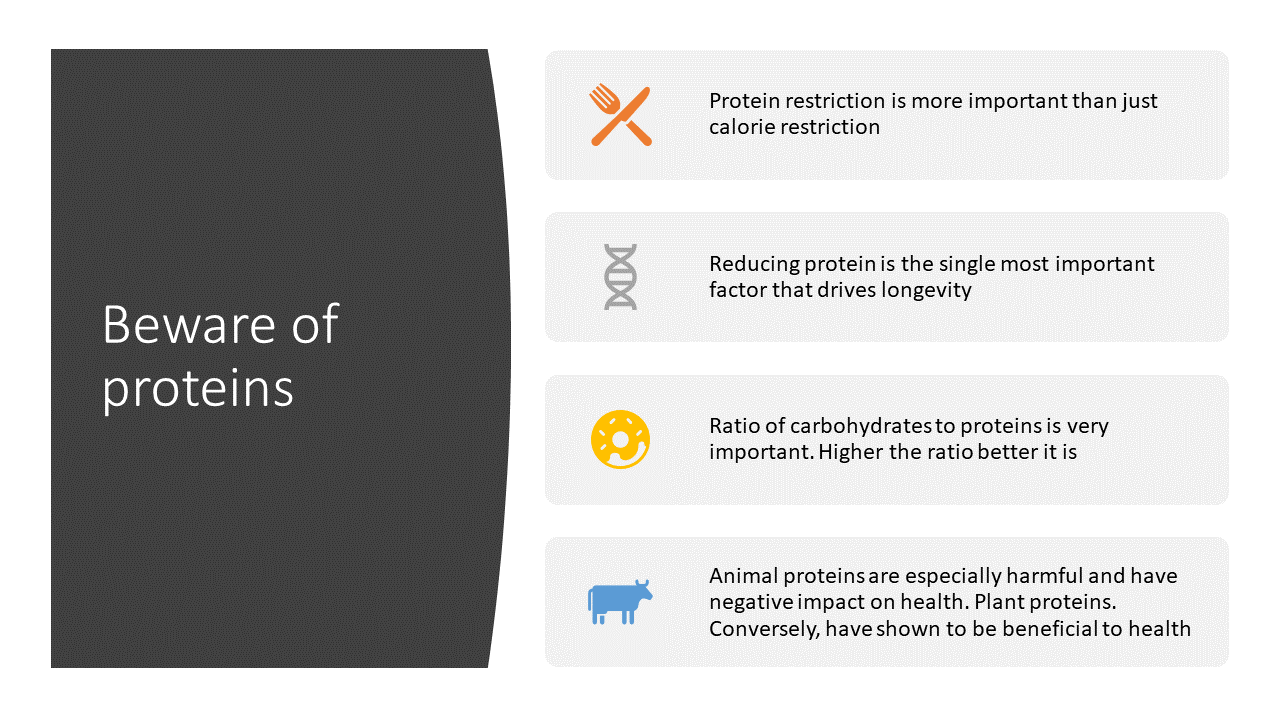 Several communities in India are strictly vegetarians. As per the sacred Hindu texts animal meat increases body heat, adding to aggression, anger and ill- health. Hence, the Brahmins (the ones who were supposed to lead intellectual work) strictly prohibited intake of meat to ensure highest intellectual attributes. Conversely Kshatriyas, who were the fighter class, promoted intake of animal meat because animal meat made their bodies worthy of aggression. But the evidences showing negative health impacts of excessive intake of animal meat are conclusive. Is this reason why abstinence of meat is considered as fasting ritual in Hinduism?
Several communities in India are strictly vegetarians. As per the sacred Hindu texts animal meat increases body heat, adding to aggression, anger and ill- health. Hence, the Brahmins (the ones who were supposed to lead intellectual work) strictly prohibited intake of meat to ensure highest intellectual attributes. Conversely Kshatriyas, who were the fighter class, promoted intake of animal meat because animal meat made their bodies worthy of aggression. But the evidences showing negative health impacts of excessive intake of animal meat are conclusive. Is this reason why abstinence of meat is considered as fasting ritual in Hinduism?
What did we learn about fasting? Quick Summary
Based on all the research and evidences, I would like to conclude by suggesting following points:
- Fast as frequently as possible: Fasting should be adopted as regular practice irrespective of what religion you belong to. Religion prescribed schedules allow you to put a discipline to this practice and bring the advantage of group effect when everyone around you follows the same discipline.
- Ensure high carbohydrate/ protein ratio: Whatever diet you adopt, ensure majority of energy comes from carbohydrates compared to proteins
- Prefer proteins from vegetarian sources: Proteins from vegetarian sources are healthier and, if possible, should constitute your majority of protein intake.

Before I end this article, let me briefly leave you with real story.
Okinawa is an island in Japan. On this island people live really long healthy lives. Number of people living more than 100 years is five times larger than that in other developed nations. Deaths due to cancer and heart diseases in Okinawa were found to be only 60–70% of those in other regions of Japan on average. The all-cause mortality rate among 60- to 64-year-olds in Okinawa was only half that of other Japanese populations. Research conducted revealed that Okinawan adult population had a low caloric intake compared to any average Japanese (83% of the Japanese average). Therefore, it has been hypothesized that this caloric restriction might be allowing Okinawans to live longer and healthier compared to rest of the population in Japan. It is interesting to analyze the normal routine diet of Okinawans. The routine Okinawan diet includes a high intake of green leafy and yellow root vegetables, sweet potatoes (as a dietary staple), and soy (as the principle protein), supplemented with small amounts of fish and meat. Only 9% of energy requirements of a typical Okinawan comes from proteins while 85% comes from carbohydrates. Protein to carbohydrate ratio in their diets (1:10) is very low.
What you should do is think about this story (which is an existing fact) and try linking it with whatever we have discussed. I hope this Okinawan secret of long healthy really sums up what we have been discussing here.
This entire article has been developed based on currently available scientific evidences. But, it turns out that our age old traditions were at least right about fasting. Some might say that when fasting was made a custom by any religion, they did not know science and it is just serendipitous that fasting is scientifically a good practice. That might be so, and I have no way to prove or disprove this criticism. But your views and comments are welcome and I would be happy to respond.



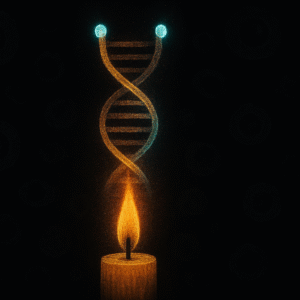

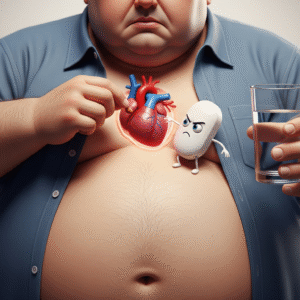
Very nice information…
Thank you!
Are there specific fasting schedules recommended by science? Especially for diabetics or pre-diabetics?
Yes. There are. The recommendations are based on how the sugar levels are varying over the day and the medicines need to be customized according to individual needs. Its a topic that will need altogether a whole new post!
Hi. Fantastic article! A couple of questions which I would request of you.
1. What then is the idel carb to fat to protien ratio? I have been reading that the body needs 1 gm of protien for each gram of fat as well?
2. Please Define fasting? Is it restricting some food groups like salt, eating only fruits all day? Is it not eating anything for a window including water, tea, coffee?
My limited research hasn’t led me to come to a perfect carbohydrate to protein ration. Okinawa analysis suggests 10:1 is a great ratio. But maybe less is also ok. But one thing is sure- the ratio should never be less than 1. Carbohydrates must always be greater than proteins.
The definitions are already part of this article: https://wisethalamus.com/surprising-science-of-fasting/#Let_Us_Define_Fasting_First
Hope this works!
Our traditional rituals has a scientific approach and that is why adopted by masses. It has become rituals with practices over centuries and generations forgot the essence of the rituals. The more we study these rituals on science tifc sale more we will wonder to find how scientific they are. When these practices were adopted that time studies were received and practices and not just documented as papers and published for few who has access. To make any right practice one need to practice and we practiced it and when those who were having no ideas about it named these practices as supercious one on the basis of their so called studies and scientific research. Did those labeled these practices as rituals ever tried to study….No
Thanks Sunataji!
Great read!
Thanks Liju!
Crash course on fasting! I’ve never seen such a detailed scientific information being explained in such a simple manner..
Way to go Dr Subir!
Thanks Dr Smit!
If Fat is actually the form in which our body stores energy, why do we need carbohydrates?
So shouldn’t the diet be a combination of fats and protein with as little carbohydrates as possible?
I have tried answering this question in the article itself. Carbohydrates are abundant in nature compared to fats. Hence we have evolved in such a way that its faster to digest carbohydrates and convert the same into energy.
Proteins were never meant for producing energy primarily- the byproducts are quite toxic.
Hope I am able to answer your query, and am happy to accept any criticism.
Excellent article Subir,
I am following Intermittent Fasting with 16:8 window & finding it good not only for weight reduction but for overall health,
I just want to know is there any harm for doing it as our life style as I am doing it for last one year??
Thanks!
Hi Chhavi
I am glad that you liked the article. 16:8 intermittent fasting is very healthy and can be done daily. Just ensure you don’t over- eat during those 8 hours.
Very nice and eye opening article!
Thank you, Vinod!
Thanks for this Nice article with all the evidences. However, I am a big fan of keto theory and its phenomenal results which I have experienced. This article makes me read and explore more specially the carb/protein ratio.
Thanks Dr Patil. I am also a huge fan of keto for quick weight loss. However, I am now clearly concerned about the long term health implications of any protein dominant diet. The current evidences clearly prove beyond any doubt that in the long run caloric discipline (via fasting) with high carb: protein ratio is the key to good health. However, I am open to counter- evidences and if I find anything convincing, I will keep you posted.
norco and ibuprofen https://ibuprofenusca.com/
I didn’t understand the question. Are you asking this in relation to some aspect of fasting?
I read your article carefully, it helped me a lot, I hope to see more related articles in the future. thanks for sharing.
Reading your article helped me a lot and I agree with you. But I still have some doubts, can you clarify for me? I’ll keep an eye out for your answers.
Reading your article helped me a lot and I agree with you. But I still have some doubts, can you clarify for me? I’ll keep an eye out for your answers.
Reading your article helped me a lot and I agree with you. But I still have some doubts, can you clarify for me? I’ll keep an eye out for your answers.
Can you be more specific about the content of your article? After reading it, I still have some doubts. Hope you can help me.
Thanks for sharing. I read many of your blog posts, cool, your blog is very good.
Thanks for sharing. I read many of your blog posts, cool, your blog is very good.
Greetings! Very helpful advice in this particular article! It’s the little changes that will make the most significant changes. Thanks a lot for sharing!
Your article gave me a lot of inspiration, I hope you can explain your point of view in more detail, because I have some doubts, thank you.
Can provide a link mass to your website https://ztd.bardou.online/adm
Your site’s position in the search results https://ztd.bardou.online/adm